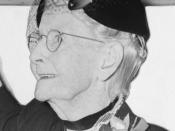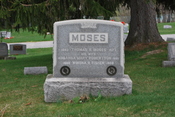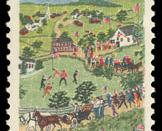Born on September 7, 1860, on a farm in Greenwich, New York, Anna Mary Robertson (who later became known as "Grandma Moses") had only a few months' schooling during the summers of her childhood. As a child Moses had drawn pictures and colored them with the juice of berries and grapes. After her husband died she created embroidery pictures, and when her arthritis made manipulating a needle too difficult, she turned to painting.
Throughout her lifetime Grandma Moses produced about 2,000 paintings, most of them oil on masonite board. Ever thrifty, she used whatever surfaces she could find: an old window, salvaged canvas from a threshing machine, even tree mushrooms, which when dry turned hard as wood. Her naive style (labeled American Primitive) was acclaimed for its purity of color, its attention to detail, and its vigor. Bright color, action and humor enlivened her portrayals of such simple farm activities.
Her tiny figures, disproportionately small, cast no shadows. They seem sharply arrested in action.
Her paintings are of people and life with genuine sincerity, the valleys, lakes, mountains, and forest, the seasons which she had lived, picturesque villages with their wooden houses and colored barns, farmyards with stables and children at play, country folk working on the land, amusing themselves or celebrating national holidays, grazing cows and horse-drawn carts.
The drawings are awkward, the composition standardized and the color sometimes dulled by another placed beside it. Theses errors, if you call them that, still produce some charming effects. Grandma Moses excelled in unfolding a large panorama, plotting the fertile lands in order-less perspective and finding the uses of colors in the most careful tones of blue, pink, green, and the range of whites and grays that she used to paint her winter landscapes.
The figures are flat and abstract...


